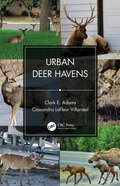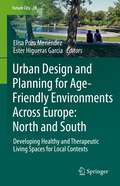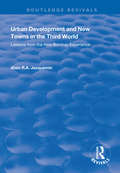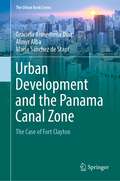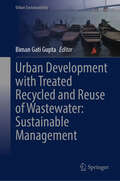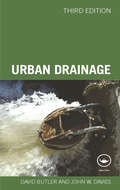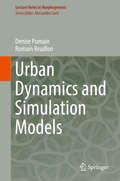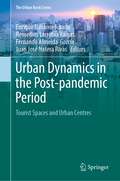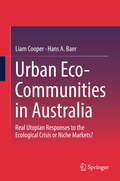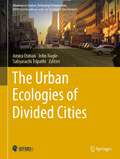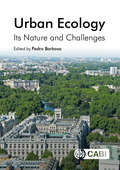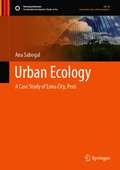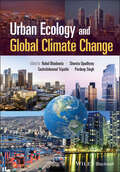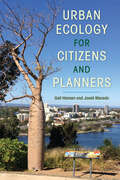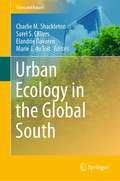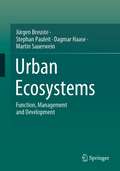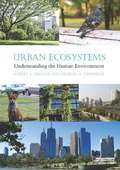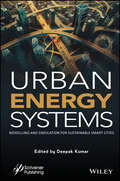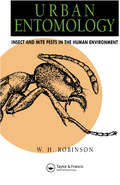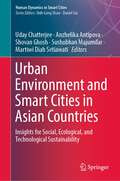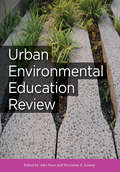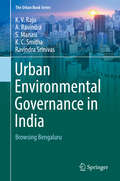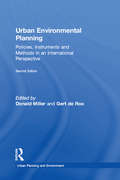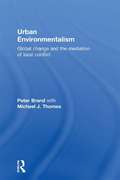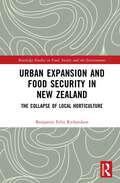- Table View
- List View
Urban Deer Havens
by Clark E. Adams Cassandra LaFleur VillarrealUrban Deer Havens consists of a thorough examination of selected cervid (deer) species that are known to inhabit urban communities in the United States. The deer species that are included in this presentation consisted of white-tailed (Odocoileus virginianus), Key deer (O. v. clavium), moose (Alces alces), elk (Cervus elaphus), mule (Odocoileus hemionus), and black-tailed deer (O. h. columbianus). This book is the first attempt to examine the similarities and differences in those factors that allow the selected cervids to exist and thrive in urban habitats. This information has never been collected, collated, reviewed, and published under one cover document. Yet, all five are known to inhabit urban communities within their geographic range. The lack of information concerning several important examples of urban cervids in conjunction with a proliferation of information on white-tailed deer only is an incomplete and biased presentation. This book is the first comprehensive source of information on urban deer management, which includes a broad assemblage of urban cervids. The overall objective of this book is to provide a more holistic examination of urban cervids. For example, it examines the similarities and differences of the environmental impacts, management strategies, and human dimensions considerations concerning urban cervids in general, and using specific examples. Urban Deer Havens features four chapters that include: Urban deer census techniques and population dynamics Comprehensive tables that review urban community deer management plans National and state-wide estimates the five selected cervids Laws and regulations concerning urban deer Lethal and nonlethal management options for managing deer Steps for managing urban deer populations Examples of urban deer management efforts
Urban Design and Planning for Age-Friendly Environments Across Europe: Developing Healthy and Therapeutic Living Spaces for Local Contexts (Future City #19)
by Elisa Pozo Menéndez Ester Higueras GarcíaThis book represents a multidisciplinary and international vision across different countries in Europe that are facing similar challenges about ageing and quality of life in present cities. It is divided in three main topics from the global context of health in cities and reduction of health inequities to the current research of different study cases, focusing on residential models and the relationship with the built environment. The third chapter illustrates best practices with some study cases from different cities in Europe. Friendlier environments for older people come together with the need of innovation, smart and updated technologies, healthier environments and mitigation of climate change. Health re-appears nowadays as one of the priorities for urban planning and design, not only for the communicable diseases and the effect of the pandemics, but also for the non-communicable diseases, that were also triggering the wellbeing and equity of our cities. Indeed, the Covid-19 pandemic has highlighted health inequities and vulnerabilities of those areas of the city that were already deprived and facing other health problems, such as obesity, diabetes, social isolation, respiratory problems or mental health issues, specifically applying for vulnerable groups. Older adults have been one of the most affected groups from the pandemic’s threats and derived consequences. In this context, the care crisis arises intertwined with the design and planning of our cities, where there is an urgent need to regenerate our environments with a perspective of sustainability, inclusion, and health prevention and promotion. From the global urban challenges to the specific contextualisation of each city and study cases, each chapter offers an updated insight of the main questions that we should consider to address urban planning and design from the perspective of ageing and social inclusion in European cities.
Urban Development and New Towns in the Third World: Lessons from the New Bombay Experience (Routledge Revivals)
by Alain R.A. JacqueminFirst published in 1999, this volume examines India and Bombay, countries which represent some of the world’s most dramatic examples of rapid urban growth. One of the strategies frequently adopted by the Indian authorities to cope with this urban growth is the development of new towns, such as New Bombay, which is India’s largest and most significant urban planning experience since Independence. The New Bombay model, based on a specific planning and financing strategy, is considered highly successful and so is increasingly being copied and implemented in other urban areas of India. This volume makes the first independent evaluation of New Bombay and sets it in a wider Third World urban development context. As well as analysing the processes of physical and economic growth, the volume also examines the process of social development and, in particular, the consequences of this planning concept for the urban poor.
Urban Development and the Panama Canal Zone: The Case of Fort Clayton (The Urban Book Series)
by Graciela Arosemena Díaz Almyr Alba María Sánchez StapfThe construction of the Panama Canal at the beginning of the twentieth century created an enclave that ran parallel to the interoceanic waterway, controlled by the US government: the Canal Zone. This book aims to understand the implications that Panama Canal Zone urban planning had on human health, natural resources, and biodiversity through the study case of Fort Clayton, highlighting how the sanitary concerns shaped building regulations and the urban landscape of towns.This book highlights the role of North American entomologists and health workers in developing control strategies for diseases transmitted by mosquitoes and how mosquito’s ecology determined building regulations that shaped the image of the Canal Zone towns. On the other hand, the book determines the environmental assessment of Fort Clayton, determined by the two fundamental aspects that set on the environmental impact of an urban settlement. The first one is the suitability of the site's location. The second is the urban structure of the adopted city model and its impact on the connectivity of the surrounding forests during the twentieth century.This text is aimed at both undergraduate and postgraduate students, architects, urban planners, historians, and environmental science professionals.
Urban Development with Treated Recycled and Reuse of Wastewater: Sustainable Management (Urban Sustainability)
by Biman Gati GuptaThis book reviews all important aspects of wastewater treatment with the aim of shedding new light on these effects through a combined understanding of traditional and new paradigms. The book is divided into five sections, the first of which reinterprets wastewater types from the point of generation, examining the characteristics and different physicochemical properties of wastewater. The second section discusses recent advances in understanding process water from surface water to groundwater. A wide range of issues in an affected area polluted by heavy chemicals and metals used in different processes lead to different results, and the book then looks at the effects in different types of water, agricultural land, fruit and vegetables in the affected area. Public health in the area of interest is also greatly affected and the details are included here in this book. The final section gives us an overview of the process and ultimately inspires many to develop better technology of energy saving plants to minimise the damage of waste treatment and restore our ecosystem and health issues. This book will be of interest to all researchers in life sciences, biology, ecology, environmental engineering and many more, especially for sustainable urban development.
Urban Drainage, Third Edition
by David Butler John DaviesUrban Drainage has been thoroughly revised and updated to reflect changes in the practice and priorities of urban drainage. New and expanded coverage includes: Sewer flooding The impact of climate change Flooding models The move towards sustainability Providing a descriptive overview of the issues involved as well as the engineering principles and analysis, it draws on real-world examples as well as models to support and demonstrate the key issues facing engineers dealing with drainage issues. It also deals with both the design of new drainage systems and the analysis and upgrading of existing infrastructure. This is a unique and essential textbook for students of water, environmental, and public health engineering as well as a valuable resource for practising engineers.
Urban Dynamics and Simulation Models
by Denise Pumain Romain ReuillonThis monograph presents urban simulation methods that help in better understanding urban dynamics. Over historical times, cities have progressively absorbed a larger part of human population and will concentrate three quarters of humankind before the end of the century. This "urban transition" that has totally transformed the way we inhabit the planet is globally understood in its socio-economic rationales but is less frequently questioned as a spatio-temporal process. However, the cities, because they are intrinsically linked in a game of competition for resources and development, self organize in "systems of cities" where their future becomes more and more interdependent. The high frequency and intensity of interactions between cities explain that urban systems all over the world exhibit large similarities in their hierarchical and functional structure and rather regular dynamics. They are complex systems whose emergence, structure and further evolution are widely governed by the multiple kinds of interaction that link the various actors and institutions investing in cities their efforts, capital, knowledge and intelligence. Simulation models that reconstruct this dynamics may help in better understanding it and exploring future plausible evolutions of urban systems. This would provide better insight about how societies can manage the ecological transition at local, regional and global scales. The author has developed a series of instruments that greatly improve the techniques of validation for such models of social sciences that can be submitted to many applications in a variety of geographical situations. Examples are given for several BRICS countries, Europe and United States. The target audience primarily comprises research experts in the field of urban dynamics, but the book may also be beneficial for graduate students.
Urban Dynamics in the Post-pandemic Period: Tourist Spaces and Urban Centres (The Urban Book Series)
by Enrique Navarro-Jurado Remedios Larrubia Vargas Fernando Almeida-García Juan José Natera RivasThis book offers a unique perspective on urban processes affecting tourist spaces and city centres. Economic, social and environmental uncertainty has been commonplace since March 2019, when mobility slowed down across the globe. The COVID-19 pandemic accelerated trends that have been investigated in urban space for years. The incorporation of technologies, the expansion of tourism and the introduction of policies that in part want to advance sustainability are generating processes of reorganisation of territories that are driving changes. These changes will affect models of city, urbanism and society.This publication is directed to a wide spectrum of people interested in urban processes, tourism and social change in the context of the Post-Pandemic Covid-19. In particular, the book is aimed at researchers, undergraduate and postgraduate students, consultants, public administrations and the public interested in the recent challenges that are affecting developed and developing societies.
Urban Eco-Communities in Australia: Real Utopian Responses to the Ecological Crisis or Niche Markets?
by Liam Cooper Hans A. BaerThis book offers one of the first detailed anthropological studies of emergent ecotopianism in urban contexts. Engaging directly with debates on urbanisation, sustainability and utopia, it presents two detailed ethnographic case studies of inner urban Australian eco-communities in Adelaide and Melbourne. These novel responses to the ecological crisis – real social laboratories that attempt to manifest a vision of the ‘eco-city’ in microcosm – offer substantial new insights into the concept and creation of sustainable urban communities, their attempts to cultivate ways of living that are socially and ecologically nourishing, and their often fraught relationship to the capitalist city beyond. These studies also suggest the opportunities and limitations of moving beyond demonstration projects towards wider urban transformation, as well as exposing the problems of accessibility and affordability that thwart further urban eco-interventions and the ways that existing projects can exacerbate issues of gentrification and privilege in a socially polarised city. Amidst the challenges of the capitalist city, climate change and ecological crisis, this book offers vital lessons on the potential of urban sustainability in future cities.
The Urban Ecologies of Divided Cities (Advances in Science, Technology & Innovation)
by Amira Osman John Nagle Sabyasachi TripathiThe book discusses how division affect the fabric of cities, and people’s sense of identity and agency, and are reflected in physical features, architecture, and urban planning. The question of divided cities represents a complex and multistranded urban Ecology—at once both social and spatial; it cannot be limited to a single science or discipline, such as social or spatial fields. This suggests integrated and cross- disciplinary understandings, as well as integrated or parallel approaches and solutions. Urban ecologies of division manifest in multiple forms. One of their most palpable expressions is conflict, with parallels around the world, and often with correlations in the spatial fabric. Violence in such contexts is often a surface expression of deeper socio-economic or ideological differences. Whether as a result of intervention by authority or by dissent between groups, a divided city inevitably becomes a place of conflict in various forms and intensity, eroding the joy of living and sense of collective belonging to the detriment of all. In effect, it erodes the collective advantage of being part of a more unified society. A city exists in collections of social structures which mutually form a society. A divided city implies divided social structures and, in consequence, a divided society. The papers compiled in this book present many case studies of divided cities, discussing the different causes of divisions and their effects on societies. Some of the causes can be linked to conflicts, wars, colonialism, or legislative political systems. In response to the serious challenges resulting from these divisions, the book aims to provide opportunities for new approaches and possibilities for new interventions and solutions, making it significant to urban planners, architects, and policymakers.
Urban Ecology: Its Nature and Challenges
by Aaron M Grade Adam J Terando Amanda E Sorensen Dennis VanEngelsdorp Elsa Youngsteadt Desiree L Narango Gail A Langellotto Heidi Liere Holly Martinson Ignacio Castellanos Iriana Zuria John G Kelcey Katherine Straley Lea Johnson Lindsay Miller Barranco Lisa Kuder Michael J Raupp Monika Egerer Nancy B Grimm Nancy Falxa Sonti Pedro Barbosa Paige S Warren Rebecca C Jordan Riley Andrade Steven Frank Steward T Pickett Susannah B LermanToday, 55% of the world's human population lives in urban areas. By 2030, up to 90% of the global human population will live in cities and the global population is expected to increase by 68% by 2050. Although land cover categorized as "urban" is a relatively small fraction of the total surface of the Earth, urban areas are major driving forces in global environmental change, habitat loss, threats to biodiversity, and the loss of terrestrial carbon stored in vegetation biomass. These and many other factors highlight the need to understand the broad-scale impacts of urban expansion as it effects the ecological interactions between humans, wildlife and plant communities. In a series of essays by leading experts this book defines urban ecology, and provides much-needed focus on the main issues of this increasingly important subdiscipline such as the impacts of invasive species, protecting pollinators in urban environments, the green cities movement and ecological corridors. The book stresses the importance of understanding ecological forces and ecosystem services in urban areas and the integration of ecological concepts in urban planning and design. The creation of urban green spaces is critical to the future of urban areas, enhancing human social organization, human health and quality of life. Urban ecology is becoming a foundational component of many degree programs in universities worldwide and this book will be of great interest to students and researchers in ecology and conservation science, and those involved in urban planning and urban environmental management.
Urban Ecology: A Case Study of Lima City, Perú (Sustainable Development Goals Series)
by Ana SabogalThis book emphasizes the necessity of green spaces and landscape planning to achieve a liveable city. It will more specifically enquire on how to reach a better liveability from the current conditions of Lima. This book takes on the one hand classic concepts from urban agronomy as are soil, water and plants, and on the other hand emphasizes the resources, the plant adaptations and the urban ecosystems, according to the context of Lima. Comparisons are also made to landscape concepts from other cities of the word, contemporary methods of urban landscape research are explained in perspectives of agronomy and ecology. The ecological restoration of some natural spaces of Lima are proposed and related to the food security which impacts on the sustainability of the city. Finally, it describes representative Parks of Lima and previous research projects that have allowed to improve the urban landscape. Considering the city's cultural diversity, comparisons to the mountain and rainforest areas are also made.
Urban Ecology and Global Climate Change
by Rahul Bhadouria Pardeep Singh Shweta Upadhyay Sachchidanand TripathiUrban Ecology and Global Climate Change Urban Ecology and Global Climate Change contains the latest practical and theoretical concepts of the emerging issues in urban ecological studies. The authors highlight some of the major challenges currently impeding ecological restoration goals in urbanized regions across the globe. It is sobering that the majority of sustainable development projects are being defeated by the increasing pace of two particular phenomena – namely climate change and urbanization. This book includes coverage of the major threats to biodiversity conservation and the most significant contributors to the deterioration of urban ecosystems. In addition, various case studies that reflect the anthropogenic interventions on ecological restoration are included. The book looks at evolving growth and urbanization concepts, monitoring of urbanization trends, land-use land cover (LULC) changes in urban and non-urban cities based on the use of open access data, urbanization affecting rural ecology, soil carbon emissions, urban development, human well-being and case studies of sustainable smart cities. Urban Ecology and Global Climate Change will find an appreciative audience amongst students of urban ecology and environmental policy, as well as policymakers, scientists and industrialists. The book provides an excellent introduction to the principles of smart city planning and urban sustainability with a view to maintaining ecological and conservation status of urban environments.
Urban Ecology for Citizens and Planners
by Gail Hansen Joseli MacedoIdeal for city residents, developers, designers, and officials looking for ways to bring urban environments into harmony with the natural world and make cities more sustainable, Urban Ecology for Citizens and Planners offers a wealth of information and examples that will answer fundamental scientific questions, guide green initiatives, and inform environmental policies and decision-making processes. This book provides an overview of the synergistic relationships between humans and nature that shape the ecology of urban green spaces. It also emphasizes the social and cultural value of nature in cities for human health and well-being. Chapters describe the basic science of natural components and ecosystems in urban areas and explore the idea of biophilic urbanism, the philosophy of building nature into the framework of cities. To illustrate these topics, chapters include projects, case studies, expert insights, and successful citizen science programs from urban areas around the world. Authors Gail Hansen and Joseli Macedo argue that citizens have increasingly important roles to play in the environmental future of the cities they live in. A valuable resource for real-world solutions, this volume encourages citizens and planners to actively engage and collaborate in improving their communities and quality of life.
Urban Ecology in the Global South (Cities and Nature)
by Charlie M. Shackleton Sarel S. Cilliers Elandrie Davoren Marié J. du ToitAgainst the background of unprecedented rates of urbanisation in the Global South, leading to massive social, economic and environmental transformations, this book engages with the dire need to understand the ecology of such settings as the foundation for fostering sustainable and resilient human settlements in contexts that are very different to the Global North. It does so by bringing together scholars from around the world, drawing together research and case studies from across the Global South to illustrate, in an interdisciplinary and comprehensive fashion, the ecology of towns and cities in the Global South. Framed using a social-ecological systems lens, it provides the reader with an in-depth analysis and understanding of the ecological dynamics and ecosystem services and disservices within the complex and rapidly changing towns and cities of the Global South, a region with currently scarce representation in most of the urban ecology literature. As such the book makes a call for greater geographical balance in urban ecology research leading towards a more global understanding and frameworks. The book embraces the complexity of these rapid transformations for ecological and environmental management and how the ecosystems and the benefits they provide shape local ecologies, livelihood opportunities and human wellbeing, and how such knowledge can be mobilised towards improved urban design and management and thus urban sustainability.
Urban Ecosystems: Function, Management and Development
by Jürgen Breuste Stephan Pauleit Dagmar Haase Martin SauerweinThis textbook on urban ecosystems answers important questions about the ecological structure, functions and socio-ecological development of cities worldwide. Based on how cities are developing today in an increasingly urbanized world, it explains ecological challenges for cities of the 21st century such as resource efficiency, climate change, moderation of quality of life and resilience. The book combines theories of urban development and ecology with practical applications and case studies, thus identifying potential for improvement and examples of good ecological urban development worldwide. It shows that cities are by far not only problem areas but also offer great potential for a good life and that the various urban ecosystems can make a considerable contribution to this. The "eco-city" is thus not a utopia,but a real goal that can be pursued step by step in a targeted manner, taking into account the local and regional context.Four renowned urban ecologists have contributed their specific experience in sub-areas without losing sight of the big picture. Jürgen Breuste is an urban ecologist and works at the Paris Lodron University in Salzburg, Austria, on the topics of sustainable urban development, urban biodiversity, ecosystem services and eco-cities. Dagmar Haase is Landschaftsökologin and works at the Humboldt University of Berlin on urban ecosystem services and land use modeling. Stephan Pauleit is a landscape planner and works at the Technical University of Munich on strategies for the sustainable development of urban landscapes. Martin Sauerwein is a geographer and works at the University of Hildesheim on geo-ecology in cultural landscapes, geoarchaeology and soil protection.The textbook addresses a broad audience of students, teachersand also to practitioners in the fields of ecology, urban ecology, urban development, sustainability, urban geography, nature and landscape conservation, spatial planning, landscape ecology, social sciences and urban studies. The numerous photos and graphics, many of them in four colors, as well as clear tables illustrate the facts. Case studies, examples and explanations allow a deeper insight. Questions at the end of each chapter allow the progress of knowledge to be checked, and a comprehensive bibliography for each chapter provides further studies.This book is a translation of the original German 1st edition Stadtökosysteme by Jürgen Breuste published by Springer Fachmedien Wiesbaden GmbH, part of Springer Nature in 2016. The translation was done with the help of artificial intelligence (machine translation by the service DeepL.com). A subsequent human revision was done primarily in terms of content, so that the book will read stylistically differently from a conventional translation. Springer Nature works continuously to further the development of tools for the production of books and on the related technologies to support the authors.This springer essential is a translation of the original German 1st edition essentials,Stadtökosysteme by Jürgen Breuste published by Springer Fachmedien Wiesbaden GmbH, part of Springer Nature in 2016. The translation was done with the help of artificial intelligence (machine translation by the service DeepL.com). A subsequent human revision was done primarily in terms of content, so that the book will read stylistically differently from a conventional translation. Springer Nature works continuously to further the development of tools for the production of books and on the related technologies to support the authors.
Urban Ecosystems: Understanding the Human Environment (Routledge Studies in Urban Ecology)
by Robert A. Francis Michael A. ChadwickWith over half of the global human population living in urban regions, urban ecosystems may now represent the contemporary and future human environment. Consisting of green space and the built environment, they harbour a wide range of species, yet are not well understood. This book aims to review what is currently known about urban ecosystems in a short and approachable text that will serve as a key resource for teaching and learning related to the urban environment. It covers both physical and biotic components of urban ecosystems, key ecological processes, and the management of ecological resources, including biodiversity conservation. All chapters incorporate case studies, boxes and questions for stimulating discussions in the learning environment.
Urban Energy Systems: Modeling and Simulation for Smart Cities
by Deepak KumarURBAN ENERGY SYSTEMS With climate change and energy issues infiltrating seemingly every aspect of our lives, it is more important than ever to continue the march toward sustainability. It is not just about switching to a gasoline-free car or installing solar panels. Many countries, including our own, are dealing with these very difficult problems by converting to “smart cities” and other “green energy” projects. This is perhaps one of the most important issues facing our world today. Urban energy systems play a critical role in the sustainability and resilience of smart cities. As cities continue to grow and face increasing energy demands, it becomes essential to develop efficient and sustainable energy solutions. Modelling and simulation techniques provide valuable insights into the design, operation, and optimization of urban energy systems, supporting the transition towards more sustainable and smart cities. This perspective highlights the importance of modelling and simulation in achieving sustainable urban energy systems and their role in shaping smart cities. Modelling and simulation play a crucial role in achieving sustainable urban energy systems and shaping smart cities. By integrating diverse energy systems, optimizing renewable energy integration, enabling demand-side management, supporting microgrid and storage system design, enhancing resilience, and facilitating policy evaluation, these tools empower decision-makers to develop and implement sustainable energy solutions. Embracing a modelling and simulation perspective in urban energy planning supports the transition towards more sustainable, efficient, and resilient smart cities that meet the energy needs of present and future generations. This book uncovers the latest research in the field of urban energy sustainability and climate management. Urban energy sustainability and climate management have been employed successfully for various purposes like human-computer interaction, decision-making, recommender systems, and so on. Data analytics have supported these applications through various efficient and effective methods. Covering all of these topics, this is a “one-stop shop” for engineers, students, policymakers, scientists, and other industry professionals working with smart cities and urban energy systems. It is a must have for any library.
Urban Entomology: Insect and Mite Pests in the Human Environment
by William RobinsonThis is a comprehensive textbook covering all aspects of entomology in the human environment. There is particular emphasis on control and biology of pests. The book provides students of entomology with a clear theoretical and practical foundation in household and structural insect pests.;This book should be of interest to senior undergraduates and masters students in entomology; pest control workers; researchers in the pesticide industry.
Urban Environment and Smart Cities in Asian Countries: Insights for Social, Ecological, and Technological Sustainability (Human Dynamics in Smart Cities)
by Uday Chatterjee Anzhelika Antipova Shovan Ghosh Sushobhan Majumdar Martiwi Diah SetiawatiThis book offers a thorough description of the challenges posed by increasing global urbanization. In addition, comprehensive perspectives are offered on how the contemporary urban challenges of our time are tackled by existing designers, architects, urban planners, and landscape architects thereby considering climate change, migration, resilience, politics, and environmental degradation. It includes insights from environmental design, geography, strategic planning, and engineering design. It goes beyond the jargon of technical innovation, and exposes the political, social and physical effects of digitalizing the world in smart cities. The book focuses on the application of geospatial technology of smart cities – including system design for basic services, real-time control and the Internet of Things. It highlights the planning of land use, strategic development, and ecosystem-based knowledge to enhance economic growth and healthy urban environment and smart city management. The book also shows the contradictory aspects of smart city studies, and provides useful insights into the creation and execution of policies to strengthen decision-making processes in smart cities. This book leads the reader to a greater understanding of smart city growth, both theoretical and realistic and as such it provides an interesting read for urban geographers, urban designers and planners, environmental specialists, practitioners, students.
Urban Environmental Education Review (Cornell Series in Environmental Education)
Urban Environmental Education Review explores how environmental education can contribute to urban sustainability. Urban environmental education includes any practices that create learning opportunities to foster individual and community well-being and environmental quality in cities. It fosters novel educational approaches and helps debunk common assumptions that cities are ecologically barren and that city people don't care for, or need, urban nature or a healthy environment.Topics in Urban Environmental Education Review range from the urban context to theoretical underpinnings, educational settings, participants, and educational approaches in urban environmental education. Chapters integrate research and practice to help aspiring and practicing environmental educators, urban planners, and other environmental leaders achieve their goals in terms of education, youth and community development, and environmental quality in cities.The ten-essay series Urban EE Essays, excerpted from Urban Environmental Education Review, may be found here: naaee.org/eepro/resources/urban-ee-essays. These essays explore various perspectives on urban environmental education and may be reprinted/reproduced only with permission from Cornell University Press.
Urban Environmental Governance in India: Browsing Bengaluru (The Urban Book Series)
by Ravindra Srinivas K. C. Smitha S. Manasi A. Ravindra K. V. RajuThis book aims to identify the challenges presented by current urban environmental governance practices in fast growing Indian cities, to propose changes to the current governance implementation strategies, and to explore the best practices to achieve sustainable urban models through Indian and global perspectives. With a focus on the city of Bengaluru, the book draws on extensive reviews of literature and data to present current trends and statuses of environmental resource use in growing urban centres of India.The book analyzes the situations that impact urban environmental governance decisions and outcomes and proposes solutions to address these issues for long-term sustainability. Policy makers, researchers, academics and development practitioners in environmental politics and urban governance will find this work of great interest.The book starts by examining different urban environmental threats on global and domestic levels, and provides evidence for the effectiveness of sustainable efforts to curb the impact of crisis-like scenarios. Then the book discusses the role of institutional regimes in influencing urban environmental outcomes through policies, and analyzes the role of various actors in the evolution of urban environmental governance from a legal perspective at global and local scales. In the final chapters, the book explores the trends and status of environmental resource management in Bangalore Metropolitan Area (BMA), and examines the dynamics of local institutions and governance structures for regulating environmental governance for promoting effective sustainable environmental governance in Bengaluru.
Urban Environmental Planning: Policies, Instruments and Methods in an International Perspective (Urban Planning and Environment)
by Donald Miller Gert De RooOriginally published in 1997, Urban Environmental Planning provides a groundbreaking overview of innovative methods and techniques for measuring and managing the environmental effects of urban land uses on other urban activities. Fully revised and updated, this second edition brings together a team of leading environmental planners and policy makers from the US, UK, Europe and SE Asia to address the central questions confronting sustainable urban development. Typical questions include: How can you measure and manage the negative environmental effects of intrusive urban activities such as manufacturing and transport on sensitive land uses including residential and recreational areas? Can a balance be found between reducing these effects through means such as separating conflicting land uses? While other sources identify the need for effective programmes to improve urban environmental quality, this volume describes and assesses analytical methods and implementing programmes practised by leading communities around the world.
Urban Environmentalism: Global Change and the Mediation of Local Conflict
by Michael Thomas Peter BrandA critical examination of urban policies and management practices used to make cities sustainable. With an international perspective, the book describes urban environmental agendas and how they arose in the context of globalization, urban economic restructuring, and the need to make cities competitive. It argues that the environment became an integral part of city development policy, turning attention not only to physical and ecological issues but also to improving the economic performance of cities and the lives of citizens. The authors also go beyond the technical issues to explore the political importance of urban environmentalism, using case studies to illustrate both its international scope and place-specific characteristics which are inexorably influencing city development throughout the world. In connecting the concept to its political effects, the book raises issues such as local democracy, equality and social regulation, all of which are increasingly concerning academics, professionals, environmentalists and city authorities alike.
Urban Expansion and Food Security in New Zealand: The Collapse of Local Horticulture (Routledge Studies in Food, Society and the Environment)
by Benjamin Felix RichardsonThis book examines suburban development in New Zealand and its conflict with and impact on local horticulture and food security. Drawing on an ethnographic study of Auckland’s rapidly expanding urban periphery, combined with comparative case studies from California in the USA and Victoria in Australia, the book examines how the profit-making strategies of property developers and landowners drastically reshapes work and life at the edge of cities. With a significant portion of the world's croplands lying adjacent to cities, the accelerating pace of urban sprawl across the planet places unprecedented pressure on the productivity and even existence of these vital food bowl regions. The book examines how the demand for more land for development at the urban periphery collides with concerns over local food security and the protection of ecosystem services. It analyses land use policy, historical records, and physical patterns of development, alongside participant observation of local events. It combines this with interviews with government officials, property developers, landowners, local residents and horticulturists. By combining these narratives of the hectic and lucrative business of suburban property development with the collapse of local horticulture, this book shows how the realignment of the New Zealand's interests of financial profitability over other concerns led to the transformation of urban peripheries from a productive food bowl to an investment vehicle. This book will be of great interest to students and scholars of urban food and agriculture, urban planning and development and rural-urban studies.
